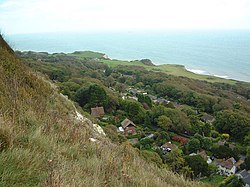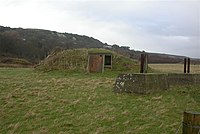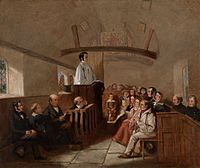St Lawrence, Isle of Wight
| St Lawrence | |
| Hampshire | |
|---|---|
 The Undercliff area of St Lawrence | |
| Location | |
| Island: | Isle of Wight |
| Grid reference: | SZ535766 |
| Location: | 50°35’14"N, 1°14’41"W |
| Data | |
| Post town: | Ventnor |
| Postcode: | PO38 |
| Local Government | |
| Council: | Isle of Wight |
| Parliamentary constituency: |
Isle of Wight |
St Lawrence is a village on the south side of the Isle of Wight, in southern Hampshire. It is located to the west of Ventnor and contiguous with it so that many would consider it a part of that town. It is however much older as a village than Ventnor.
St Lawrence is situated on the Undercliff, and is subject to frequent landslips.
Parish churches
The Lawrence Old Church, the oldest of the village's churches, dates from the 12th century, though a chancel was added in 1830. Before the chancel was built, the church was only 25 feet long and 11 feet wide, and was considered the smallest church in Britain. Although there are undoubtedly smaller chapels including the tiny church at Les Vauxbelets on Guernsey, this arguably remains the smallest to be built as a parish church.
The 'modern' Church of St Lawrence replacing the Old Church was built in the nineteenth century, and is somewhat larger than the old St Lawrence. The church has several older fittings however, brought to the church when it was built or later. There is a 15th-century font, and a stoup that is about 500 years old. A series of 18th-century hat pegs has been incorporated too. The piscina niche is almost the same age as the church. It has a 17th-century Holy Table and a chest that dates from 1612.
About the village
There was a glassworks in St Lawrence, named as Isle of Wight Glass, by the Old Park Hotel in St Lawrence, but this is now closed. Nearby is the site of the Tropical Bird Park, which is also now closed. Close to the newer church is the site of the Rare Breeds Park, which closed while the A3055 road was closed to the west of the village due to landslip.
William Spindler
St Lawrence was in the nineteenth century the subject of an ambitious plan by a German developer, named William Spindler (who had made his fortune as a chemist in Berlin), to develop St Lawrence as a resort to rival Ventnor. He lived on the Isle of Wight from 1881 to his death in 1889 and is buried in Whitwell.
During his time in St Lawrence, Spindler had an enormous influence there and on the surrounding areas. He possibly alienated local opinion with a series of "improving pamphlets" criticising local perceived laziness. His legacy has been a number of grand Victorian houses, often semi-derelict and half hidden by woodland.
Perhaps Spindler's most noticeable memorials are several huge pieces of masonry in Binnel Bay, which once formed a harbour which is all but inaccessible from the land. These have fallen into titanic ruins and are known locally as "Spindler's Follies".[1]
Outside links
| ("Wikimedia Commons" has material about St Lawrence, Isle of Wight) |


